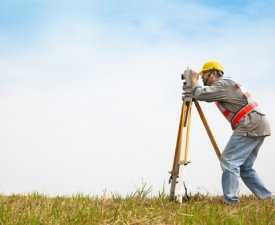Description
Course Name: Diploma in Surveying
Course Id: DS/Q0001.
Education Qualification: 10th Class.
Duration: 370 Hrs.
How You will Get Diploma Certificate:
Step 1- Select your Course for Certification.
Step 2- Click on Enroll Now.
Step 3- Proceed to Enroll Now.
Step 4- Fill Your Billing Details and Proceed to Pay.
Step 5- You Will be Redirected to Payment Gateway, Pay Course and Exam Fee by Following Options.
Card(Debit/Credit), Wallet, Paytm, Net banking, UPI and Google pay.
Step 6- After Payment You will receive Study Material on your email id.
Step 7- After Completion of Course Study give Online Examination.
Step 8- After Online Examination you will get Diploma Certificate soft copy(Scan Copy) and Hard Copy(Original With Seal and Sign).
Step 9- After Certification you will receive Prospect Job Opportunities as per your Interest Area.
Online Examination Detail:
- Duration- 120 minutes.
- No. of Questions- 60. (Multiple Choice Questions).
- 10 Questions from each module, each carry 10 marks.
- Maximum Marks- 600, Passing Marks- 40%.
- There is no negative marking in this module.
| How Students will be Graded: | ||
| S.No. | Marks | Grade |
| 1 | 91-100 | O (Outstanding) |
| 2 | 81-90 | A (Excellent) |
| 3 | 71-80 | A (Very Good) |
| 4 | 61-70 | B (Good) |
| 5 | 51-60 | C (Average) |
| 6 | 41-50 | P (Pass) |
| 7 | 0-40 | F (Fail) |
Benefits of Certification:
- Government Authorized Assessment Agency Certification.
- Certificate Valid for Lifetime.
- Lifetime Verification of Certificate.
- Free Job Assistance as per your Interest Area.
Syllabus
Diploma in Surveying
Basic Surveying
Classifications and basic principles of surveying – Equipment and accessories for ranging and chaining – Methods of ranging – Compass – Types of Compass – Basic Principles Bearing – Types – True Bearing – Magnetic Bearing, Plane Table Surveying- Parts and accessories, Methods of surveying. Two-point and three-point problems, Surveying instruments; chains, tapes, steel bands, their types & uses, Ranging & Chaining of Survey lines. Field work & Plotting of Chain survey Compass Surveying- Prismatic Compass& Surveyor compass Uses, Bearings, Local attraction, Fieldwork & Plotting. Explain Basic surveying instruments and techniques. Apply skills in using basic surveying instruments and analyze data. Apply skills to conduct traverse survey & to find the area.
Theodolite and Tachometric Surveying
Horizontal and vertical angle measurements – Temporary and permanent adjustments – Heights and distances – Tachometer – Stadia Constants – Analytic Lens – Tangential and Stadia Tachometry surveying – Contour – Contouring – Characteristics of contours – Methods of contouring – Tachometric contouring – Contour gradient – Uses of contour plan and map, Types and uses of theodolites. Temporary and permanent adjustments, Measurement of horizontal and vertical angles, Methods of Tachometric surveying, Field work and computation, Use theodolite for the measurement of horizontal and vertical angle, describe the principles and various methodologies involved in tachometry.
Basic Leveling
Leveling- Principles and theory of Leveling – Datum- – Bench Marks – Temporary and Permanent Adjustments- Methods of Leveling- Booking – Reduction – Sources of errors in Leveling – Curvature and refraction, General principle. Types of levels and their temporary and permanent adjustments, Methods of leveling, Reduction of levels, Precise leveling and Trigonometric Leveling, Apply the knowledge of leveling in different operations in civil engineering projects. Summarize the principles and purpose of basic leveling in surveying, Formulate the Trigonometric and leveling methods, setting up of plane table, leveling, centering & orientation, surveying an area with plane table by radiation & intersection methods.
Total Station Surveying
Total Station : Advantages – Fundamental quantities measured – Parts and accessories – working principle – On board calculations – Field procedure – Errors and Good practices in using Total Station, Total station-general commands used- instrument preparation and setting-reading distances and angles, Measurement of distances and coordinates of given points, using EDM and Total station, Measurement of altitudes of given elevated points, using total station, Use total station in the field of civil engineering land survey, Define the vertical and horizontal angle measurement mechanism of Total Station instrument. Define the advantage and disadvantage of Total Station surveying.
Global Positioning System
GPS Surveying: Different segments – space, control and user segments – satellite configuration – signal structure – Orbit determination and representation – Anti Spoofing and Selective Availability – Task of control segment – Hand Held and Geodetic receivers – data processing – Traversing and triangulation, Demonstration of GPS surveying followed by processing of collected data, Apply optimal insights into land surveying using GPS, Practice in differential leveling reciprocal leveling, establishing bench marks, Height of collimation and Rise & Fall methods.
Modern Surveying
Curve Surveying-Curves – Necessity – Types, Simple curves, Elements, Designation of curves, Setting out simple curves by linear methods, Transition curves Characteristics, Vertical curves –Types. Introduction to Geodetic Surveying, Principal &classification of triangulation system, Selection of base line and stations, Orders of triangulation-triangulation figures, Station marks. Field Astronomy Introduction &Instruments purpose, Astronomical terms, Time & conversion of time, Abbreviations, Determination of azimuth, Latitude and longitude Photogrammetric Surveying-Introduction, principle, uses Aerial camera, aerial photographs Definitions, scale of vertical and tilted photograph Ground coordinates, ground control.

